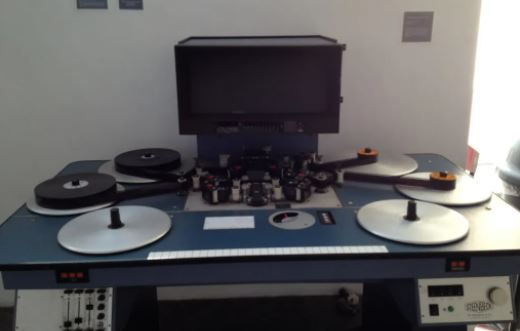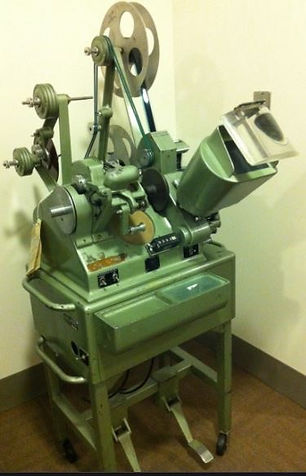DALE HAWES
Editing on a
STEENBECK
Post Production Before Computers

How did they edit feature films before computers?
Answer: They took a razor-blade & tape and cut & spliced the film.
The original way to cut film was a system that employed a Moviescop witch is a viewing monitor, a slicing block to cut & splice the film, and 2 hand-cranks to hold the supply and take up reels. The hand cranks were secured to a table and the Moviescop was placed in between the two cranks. The film was fed from one reel, through the Moviescop, then taken up by the other reel. You'd play the film by turning the right hand crank. In the very beginning of filmmaking the editor would cut the original negative (the camera original) and once the whole film was spliced together they would make exhibition prints off of the newly assembled negative. The problem with this system is if you made a bad edit, you were most likely stuck with the mistake because there was only one camera original. In later years they fixed this problem by taking the camera original negative to the lab and making a number of prints. One of the prints went to the director to watch the next day (this was called viewing the dailies). The dailies were where the director made his notes to the editor, telling him what shots he liked. Another print went to the editor to cut up as he pleased. If a mistake was made he could just order another print. Also the editor could scratch up the editor’s print as much as he wanted because nobody was going to use it to make an exhibition print.
In 1927 Iwan Serruier adapted his new home movie viewing system into a professional editing machine. This was done at the request of an editor at Douglas Fairbanks Studios. This new editing machine was called a Moviola. It became very popular because the whole editing apparatus was one 1 machine playing the picture and then later, sound reels, instead of 3 or 4 separate devices placed on a table. Plus, unlike the old set up, the Moviola was motorized witch insured an accurate playback speed. Movieolas were the popular choice for the professional for most of the 20th century. But by the 1970s everyone wanted the new kind of editing machine. It was the Steenbeck Tabletop Editor. The Steenbeck could play 2 picture reels and a sound reel, and also had a viewing monitor and speakers. Sometimes the table top editor had two viewing monitors, one for each picture reel. Though Steenbeck's became the pro's choice from the 1970s and on, Moviolas were still employed right up until the digital revolution of filmmaking just before the beginning of the 2000's.
The sound reels were just like the picture reel. It was 35mm film complete with sprocket holes but it was completely transparent and had a strip of magnetic audio tape glued to it along one side.
In order to synchronize the picture and sound reels while editing, the editor relied on something called, The Slate (aka, The Clapper / aka, Sticks). On the set during filming, while the camera and sound first start recording, a crew member would place the slate in front of the camera and then he would recite the movie title, shot number and take number and then open and close the clap sticks, slapping them together loudly. They also had the movie title and shot & take number written down on the slate. So back in the editing room, the editor could hear the guy recite the shot and take on the audio reel and on the picture reel he could read the shot and take on the slate. That's how editor knew what audio went with what picture. But to synchronize the two he would listen for the clap sticks on the audio reel then mark the spot where he heard the clap with a china marker. Then on the picture reel, he’d look frame by frame for the frame when the sticks make contact and mark it. He would then lock those points together on the editing system and the two reels would run in sync from then on.
When the editor and the director of the film both decided they at last had the final cut, the assembled film would get sent to a negative cutter who would then cut up the camera original negative in the exact same order the editor cut his print. The negative cutter knew exactly where to cut the film because along the edge of the negative were printed frame numbers, every so often. Since the editor’s print was taken from the camera negative, the numbers obviously matched. At this point the negative cutter would cut the feature into an “A roll” and a “B roll. The negative cutter would cut 2 frames before the actual starting point of each shot and 2 frames after the end of each shot. He did this so he could use those 2 frames to glue and splice the film to black leader. Glue was preferred over tape because it was a stronger hold and also the tape would blur the frames around the cut. So, as both the rolls play consecutively, on the A roll they’d put the first shot, and black leader at that same spot on the B roll. Then, the second shot would be on the B roll and they’d have black leader on the A roll, and so on. Each consecutive shot on the opposite roll. When it came time to make the exhibition prints they'd marry the two rolls together by double exposing the new print with both A and B rolls. Only one shot would be exposed to the print at any time because black leader was blocking the light on the opposite roll from exposing the print. But also with an A/B roll system you could do a dissolve by having both rolls exposed consecutively, but one roll continually fades from black to clear, then on the other roll the leader would fade from clear to black. You could also do a wipe, or an iris transition by animating a mat on both rolls, one the exact opposite of the other. Not only that, but you could do composite shots by combining two separate elements into one shot. Both shots would be exposed at the same time but you’d paint a mat over each shot blocking out the elements you didn’t want seen on that roll. An example of this would be, in one shot you might have a model of a spaceship floating across the frame and on the other shot is a painting of outer space. The mat over the first shot blocked out everything except the spaceship while the mat over the second shot blocked out only the spaceship. When you married the two images together, it appears like the spaceship is flying through outer space. It may be interesting to learn that in order to sync up the master picture reel and the master sound reel you would use something called academy leader. Academy leader is the first thing you see on the picture reel. It is a count down from 8 - 2. Each number appears on the screen for 1 second (or 24 frames) except for the number 2, which only is on the screen for 1 frame (or 1/24th of a second). At the same point in the picture reel that the 2 appeared you would cut in a “Bleep” sound onto the audio reel. You then can lock in sync both reels to the 2 frame and the bleep and your film will playback in sync every time. The academy leader with the countdown would remain on the film even after you married the picture track and soundtracks together to make the exhibition print. But once the film was shipped to the cinema the venue's projectionist would cut the academy leader out and attach the theater bumpers and coming attraction trailers.
The editor cut the picture reel and the dialogue reel at the same time. But the dialogue was not the only track of sound. You would also have a sound effect reel for the synced sounds of a car crashing, a door slamming, a punch in the face, a gun firing and the like. You would also have a "presents" reel witch was the blank room noise of the space the action was filmed. The "presents noise" hid the editing cuts of the dialogue track, making the dialogue sound seamless. You could also have an atmosphere track to create illusion of a location (for example if you build the set of a police station on a soundstage for a scene, you might add the sound of some police station background noise on top of the presence track) Also, you would have a music track for non-diegetic music (Music we hear that sets the mood for the scene but does not exist in the world we are creating). And another track for diegetic music (music that dose exists in the world we are creating, such as music coming out of a radio in a car our hero is driving). In addition, you may need more reels of sound for a narrator or countless other sound elements. Even without mixing to a stereo or Dolby Stereo or any other multi track theatrical system, just mono sound, you could have up to 24 reels of soundtracks that would be taken to the sound mixer. The sound mixer had a room with a wall of machines that would take the multiples of reels and play them in sync. Then the sound mixer mixed them into one master sound reel.
Film credits were created by a machine called a Rotoscope. A Rotoscope was also the machine they used to animate cartoons.
Before the A and B roll and soundtrack reel were married into an exhibition print, the lab would create an answer print to screen for the director so he could have one last chance to correct the color timing of the film before the film officially went to print.
The end of this cut and paste style of editing started in the late 1990's with the introduction of a computer video editor called, The Avid. In order to edit on the Avid, one would transfer the film to video and time code the video. Then you would edit your film on the computer and the computer would make a list of each shot and what frame to cut on based on the videos time code. This paper edit would then go to the negative cutter. Also with the Avid you could do much of the sound editing right there in the computer, rather than hauling 24+ reels to your sound mixer. The movie, "Office Space" (1999), proudly proclaimed in the closing credits that their film was edited on a computer. But by 2010 very few cinemas were projecting actually celluloid film and by 2015 nobody was shooting on celluloid any more. Today, computers do it all.
Speaking as someone who used to cut film on a Steenbeck, I'll always miss holding the film in my hand as I cut. But I'm a product of another time.
- D Hawes



